
How to Use A4988 Stepper Motor Driver (Red): Examples, Pinouts, and Specs
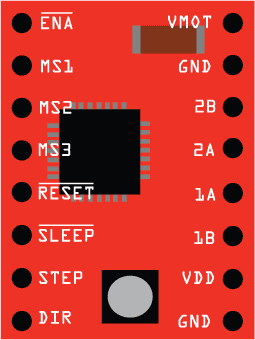
 Design with A4988 Stepper Motor Driver (Red) in Cirkit Designer
Design with A4988 Stepper Motor Driver (Red) in Cirkit DesignerIntroduction
The A4988 Stepper Motor Driver (Red) is a compact and versatile driver module designed for controlling bipolar stepper motors. It features adjustable current control, microstepping capabilities, and built-in over-temperature and short-circuit protection. This module is widely used in applications requiring precise motor control, such as 3D printers, CNC machines, robotics, and automation systems. Its ability to operate in full-step, half-step, quarter-step, eighth-step, and sixteenth-step modes makes it ideal for achieving smooth and accurate motor movements.
Explore Projects Built with A4988 Stepper Motor Driver (Red)
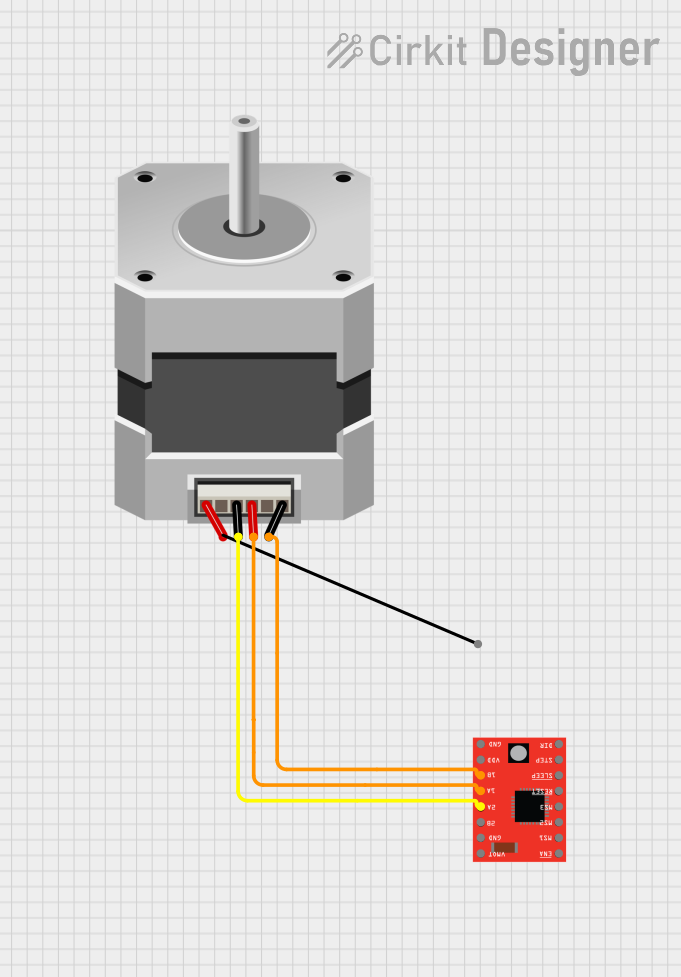
 Open Project in Cirkit Designer
Open Project in Cirkit Designer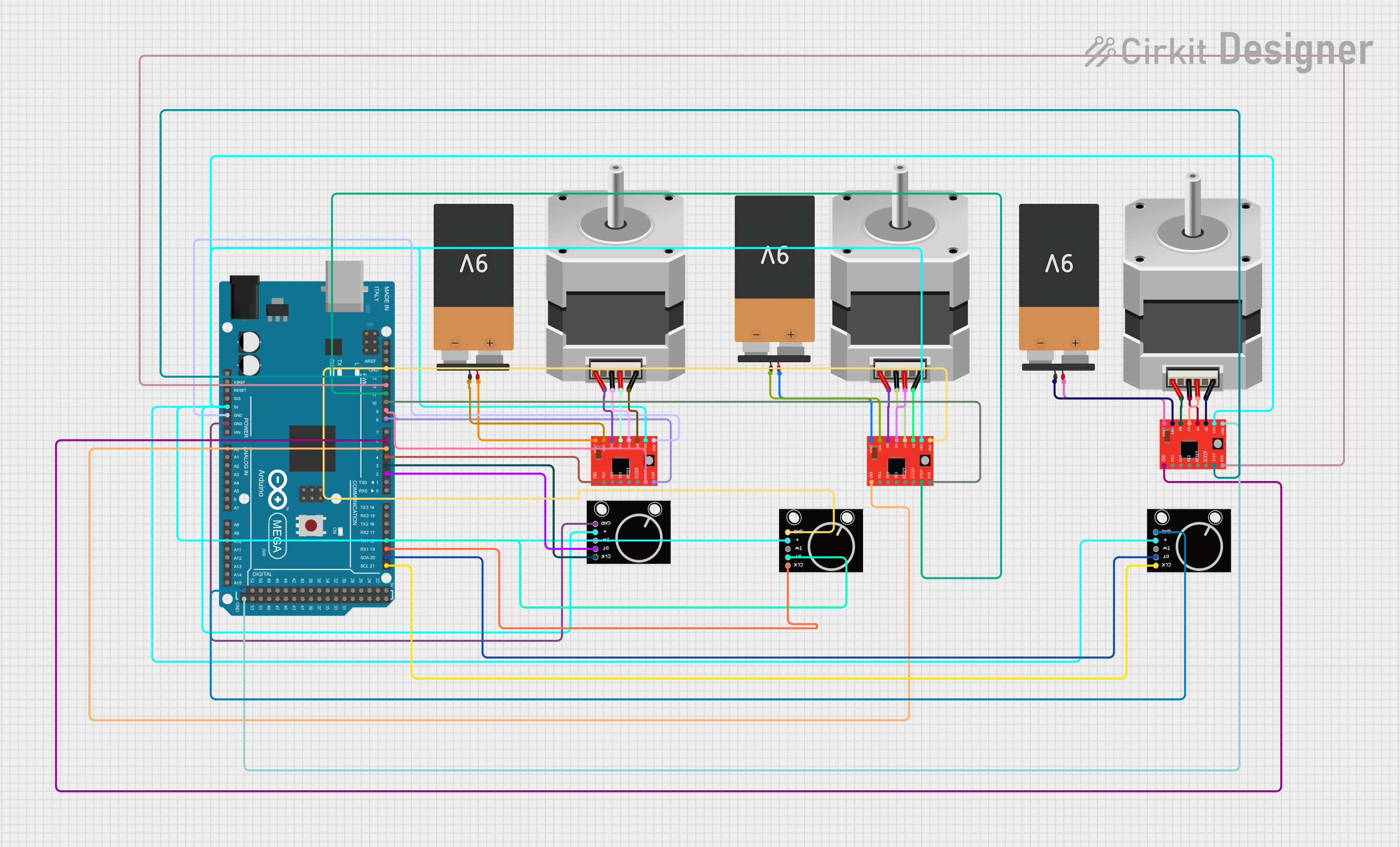
 Open Project in Cirkit Designer
Open Project in Cirkit Designer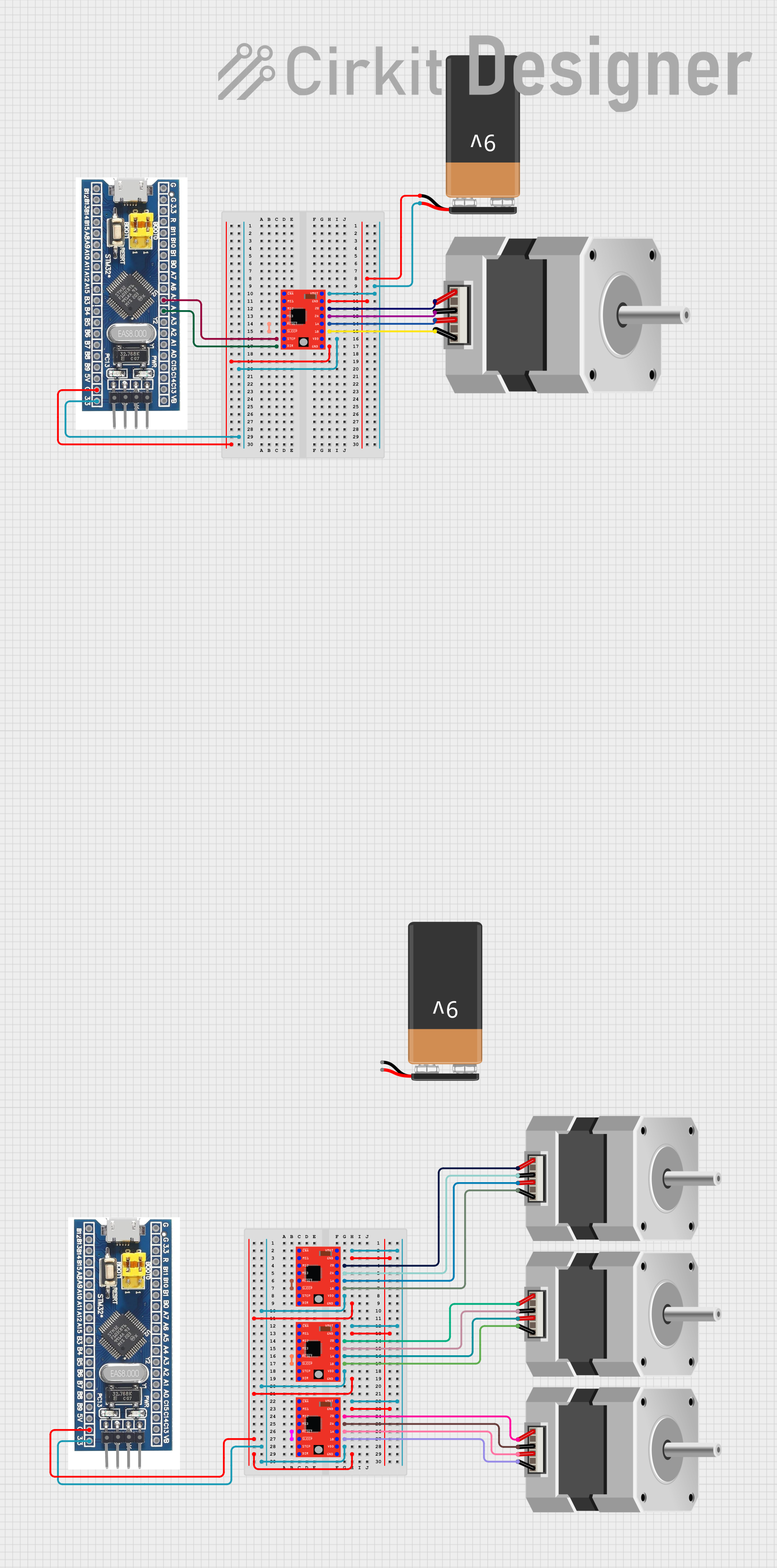
 Open Project in Cirkit Designer
Open Project in Cirkit Designer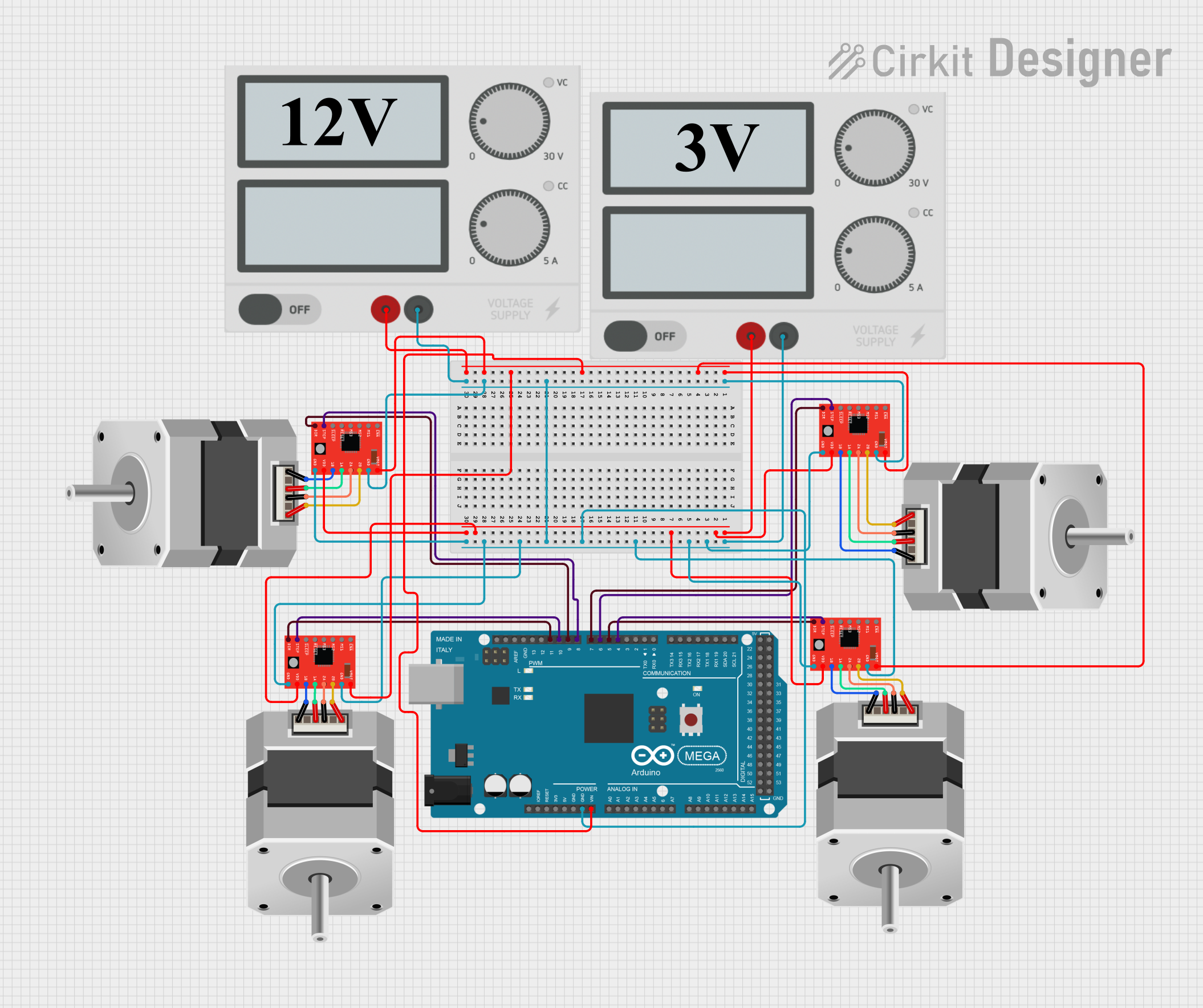
 Open Project in Cirkit Designer
Open Project in Cirkit DesignerExplore Projects Built with A4988 Stepper Motor Driver (Red)

 Open Project in Cirkit Designer
Open Project in Cirkit Designer
 Open Project in Cirkit Designer
Open Project in Cirkit Designer
 Open Project in Cirkit Designer
Open Project in Cirkit Designer
 Open Project in Cirkit Designer
Open Project in Cirkit DesignerTechnical Specifications
- Input Voltage (VMOT): 8V to 35V
- Logic Voltage (VDD): 3.3V to 5V
- Maximum Output Current: 2A per coil (with sufficient cooling)
- Microstepping Modes: Full, 1/2, 1/4, 1/8, 1/16 steps
- Current Control: Adjustable via onboard potentiometer
- Protection Features: Over-temperature, over-current, and short-circuit protection
- Dimensions: 20mm x 15mm x 11mm (approx.)
Pin Configuration and Descriptions
| Pin Name | Pin Number | Description |
|---|---|---|
| VMOT | 1 | Motor power supply (8V to 35V). Connect to the stepper motor's power source. |
| GND | 2, 3 | Ground connection for motor and logic power supplies. |
| VDD | 4 | Logic power supply (3.3V or 5V). |
| STEP | 5 | Step input. A rising edge on this pin advances the motor by one step. |
| DIR | 6 | Direction input. High or low determines the motor's rotation direction. |
| ENABLE | 7 | Enable input. Pull low to enable the driver; pull high to disable it. |
| MS1 | 8 | Microstepping mode selection pin 1. |
| MS2 | 9 | Microstepping mode selection pin 2. |
| MS3 | 10 | Microstepping mode selection pin 3. |
| RESET | 11 | Reset input. Pull low to reset the driver. |
| SLEEP | 12 | Sleep mode input. Pull low to put the driver into low-power mode. |
| OUT1A | 13 | Output 1A. Connect to one coil of the stepper motor. |
| OUT1B | 14 | Output 1B. Connect to the other end of the same coil. |
| OUT2A | 15 | Output 2A. Connect to the second coil of the stepper motor. |
| OUT2B | 16 | Output 2B. Connect to the other end of the second coil. |
Usage Instructions
How to Use the A4988 in a Circuit
Power Connections:
- Connect the motor power supply (8V to 35V) to the VMOT pin and ground to the GND pin.
- Connect the logic power supply (3.3V or 5V) to the VDD pin and ground to the GND pin.
Motor Connections:
- Connect the stepper motor's two coils to the OUT1A, OUT1B, OUT2A, and OUT2B pins. Ensure the correct pairing of the motor wires.
Control Pins:
- Use the STEP pin to control the motor's steps. Each rising edge on this pin advances the motor by one step.
- Use the DIR pin to set the motor's rotation direction (high for one direction, low for the opposite).
- Configure the microstepping mode by setting the MS1, MS2, and MS3 pins according to the table below:
| MS1 | MS2 | MS3 | Microstepping Mode |
|---|---|---|---|
| Low | Low | Low | Full Step |
| High | Low | Low | Half Step |
| Low | High | Low | Quarter Step |
| High | High | Low | Eighth Step |
| High | High | High | Sixteenth Step |
Adjusting Current Limit:
- Use the onboard potentiometer to set the current limit. This prevents the motor from drawing excessive current and overheating.
Enable and Sleep Modes:
- Pull the ENABLE pin low to activate the driver. Pull it high to disable the outputs.
- Pull the SLEEP pin low to put the driver into low-power mode.
Example Code for Arduino UNO
// A4988 Stepper Motor Driver Example Code
// This code demonstrates basic control of a stepper motor using the A4988 driver.
#define STEP_PIN 3 // Connect to the STEP pin of the A4988
#define DIR_PIN 4 // Connect to the DIR pin of the A4988
void setup() {
pinMode(STEP_PIN, OUTPUT); // Set STEP pin as output
pinMode(DIR_PIN, OUTPUT); // Set DIR pin as output
digitalWrite(DIR_PIN, HIGH); // Set initial direction (HIGH or LOW)
}
void loop() {
// Generate a step pulse
digitalWrite(STEP_PIN, HIGH); // Set STEP pin HIGH
delayMicroseconds(1000); // Wait for 1ms (adjust for speed control)
digitalWrite(STEP_PIN, LOW); // Set STEP pin LOW
delayMicroseconds(1000); // Wait for 1ms (adjust for speed control)
}
Important Considerations
- Ensure proper heat dissipation for the A4988 module, especially when driving motors at high currents. Use a heatsink or active cooling if necessary.
- Avoid connecting or disconnecting the motor while the driver is powered, as this can damage the module.
- Double-check the motor's wiring to ensure the coils are correctly paired.
Troubleshooting and FAQs
Common Issues and Solutions
Motor Not Moving:
- Verify the power supply connections to VMOT and VDD.
- Check the STEP and DIR signal connections and ensure they are receiving proper signals.
- Ensure the ENABLE pin is pulled low to activate the driver.
Motor Vibrates but Does Not Rotate:
- Check the motor wiring. Ensure the coils are correctly paired.
- Verify the microstepping mode configuration (MS1, MS2, MS3).
Driver Overheating:
- Reduce the current limit using the potentiometer.
- Add a heatsink or active cooling to the driver.
Motor Moves Erratically:
- Ensure the STEP signal timing is consistent and within the driver's specifications.
- Check for loose or faulty connections.
FAQs
Can I use the A4988 with a unipolar stepper motor? No, the A4988 is designed for bipolar stepper motors only.
What happens if I exceed the current limit? The driver will enter thermal shutdown or over-current protection mode to prevent damage.
Can I control multiple A4988 drivers with one Arduino? Yes, you can control multiple drivers by assigning separate STEP and DIR pins for each driver.
By following this documentation, you can effectively use the A4988 Stepper Motor Driver (Red) for precise and reliable stepper motor control.